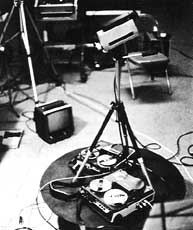[ index | 1965 | 1970 | VIDEO ]
SONY CV PORTAPACK
"In 1963, the very first home videotape recorder appeared in the Nieman-Marcus Christmas catalog. It was from Ampex; it was called the Signature V; it cost $30,000 (...) It was the size of a coffin; it weighed more. (...)
"Sony, active in the industrial video arena for years, introduced its CV series half-inch, black/white open-reel format in 1965. (...) 'CV' ostensibly stood for 'consumer video,' and machines actually were sold to home users in such big-ticket emporiums as Neiman-Marcus. The first CV machine (which weighed in at a mere 70 pounds) even had a built in nine-inch monitor that popped up for viewing. The format initially produced jittery, flickering images, but incorporated some features that later became well loved, such as timer recording. Although it didn't make much of a splash in the stores, CV made it into some school systems. One (((Video Review))) editor remembers making his television debut on his grammar school's closed circuit TV channel, which employed CV equipment. By the end of the 60's, Sony went back to the drawing board.
- Source: Video Review, April 1991, pp. 32, 34-35

The introduction of the portapack into artistic formulation was paramount. In the late 1960's the use of video was confined to close circuit installations, a very elegant solution to the use of video in the gallery. With the invasion of tape on the scene it took some time to settle the problem of exhibition. Speaking to Steina about reel to reel machines Bruce Nauman put it more directly: "I almost dropped video when tape was introduced; when the tape ran out there was no one in the gallery to rewind it, thread it and run it again."
It was an entirely different story for the socially engaged. The portapack was considered a revolutionary tool, almost a weapon against the establishment. Overnight it dissolved the hegemony of documentary films. A vast number of genres sprang up (including the notorious 30 minute single take), and the documentary branch was never the same again.
The middle ground was also interesting. With tape new networks of distribution were quickly established. Video became truly international. It was easy to duplicate, mail, and view. With the introduction of the video cassettes in 1973 it became even easier, and harmonized with the exhibtion purposes of video. By the mid-1970's video as art was fully entrenched in the galleries, with many developed genres, forms and concepts.
Only a few people tried to develop the so-called "abstract" genre. It failed in the first decade entirely. We and other people dealing with early synthetic images used tape primarily as extended studio material (input), and secondarily as a method of documentation of these new processes and phenomena unexpectedly popping up in front of our eyes.
— Woody Vasulka, SONY CV PORTAPACK, EIGENWELT DER APPARATEWELT, 1992
[ index | 1965 | 1970 | video synthesizers ]